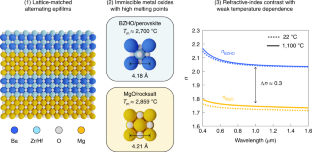2022-09-22 アメリカ合衆国・ミシガン大学

・ ミシガン大学とバージニア大学が、高温度を耐熱する新しいナノフォトニック材料を開発。
・ ペロブスカイトと酸化マグネシウム(MgO)を組み合わせたヘテロ構造材料で 2,000℉(約 1,100℃)の
高温度下でも安定性を維持し、従来のアプローチを 2 倍近く上回る。赤外光エネルギーを反射して短い波長を透過させる相殺的干渉と呼ばれる現象により、PV、赤外線画像、遮熱コーティング、センシングや赤外線探知デバイスからの隠蔽等のアプリケーションに有用となる。
・ 白色光の波長以外を反射して発色する蝶の羽の微細構造のように、新ナノフォトニック材料構造は赤外光以外の波長を吸収する。このような発色構造の高温下での維持が課題となっていた。
・ 発泡体やセラミクスを使用して赤外光の放出を制限する現行の熱エミッタの材料は高温度下でも安定するが、透過波長の調整能力に欠ける。
・ ナノフォトニクスでは波長の調整がより容易だが、高温度下では融解・酸化するため安定性を維持した例が見られない。また、ナノフォトニック材料の多くは、真空下でのみ安定性を維持できる。
・ 新材料ではこれらの課題に対処し、大気下で安定するフォトニック結晶の耐熱性の記録を更新。また、多様なアプリケーションに適したエネルギーの調整も可能になる。既存の熱光起電力セル(TPVs)
に使用した場合、効率性が 10%向上し、最適化することでさらに大幅な向上も可能と予測する。
・ 高温度下でも光の反射が制御できる、完全に分離した屈折率のミスマッチ層を維持する材料として、MgO とペロブスカイトを組み合わせた結晶構造に注目し、スーパーコンピューターによるシミュレーションで確認。
・ パルスレーザー成膜(PLD)法で滑らかな界面のヘテロ構造を作製。従来的なフォトニック材料に代わり、酸化物を利用して耐熱性を向上させた。酸化物はより精確な積層が可能で高熱下でも劣化しにくい。
・ コンピューターモデリングを通じ、候補となりそうな材料の数百種類の組合せを特定。商業利用はかなり先となるが、本研究の発見は 様々なアプリケーションに向けた多様な新材料の開発を助ける、ナノフォトニック材料の新たな研究の活路を開くもの。
・ 本研究は、米国国防高等研究計画局(DARPA)が支援した。
URL: https://news.umich.edu/heat-resistant-nanophotonic-material-could-help-turn-heat-into-electricity/
<NEDO海外技術情報より>
関連情報
Nature Nanotechnology 掲載論文(アブストラクトのみ:全文は有料)
Nanophotonic control of thermal emission under extreme temperatures in air
URL: https://www.nature.com/articles/s41565-022-01205-1
Abstract
Nanophotonic materials offer spectral and directional control over thermal emission, but in high-temperature oxidizing environments, their stability remains low. This limits their applications in technologies such as solid-state energy conversion and thermal barrier coatings. Here we show an epitaxial heterostructure of perovskite BaZr0.5Hf0.5O3 (BZHO) and rocksalt MgO that is stable up to 1,100 °C in air. The heterostructure exhibits coherent atomic registry and clearly separated refractive-index-mismatched layers after prolonged exposure to this extreme environment. The immiscibility of the two materials is corroborated by the high formation energy of substitutional defects from density functional theory calculations. The epitaxy of immiscible refractory oxides is, therefore, an effective method to avoid prevalent thermal instabilities in nanophotonic materials, such as grain-growth degradation, interlayer mixing and oxidation. As a functional example, a BZHO/MgO photonic crystal is implemented as a filter to suppress long-wavelength thermal emission from the leading bulk selective emitter and effectively raise its cutoff energy by 20%, which can produce a corresponding gain in the efficiency of mobile thermophotovoltaic systems. Beyond BZHO/MgO, computational screening shows that hundreds of potential cubic oxide pairs fit the design principles of immiscible refractory photonics. Extending the concept to other material systems could enable further breakthroughs in a wide range of photonic and energy conversion applications.




